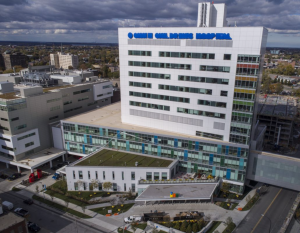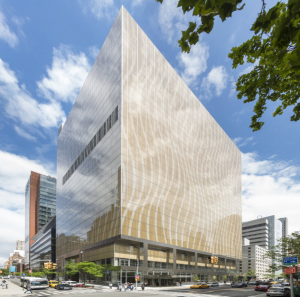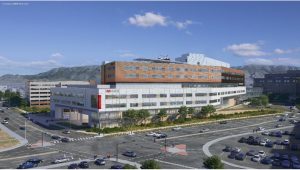Kaleida Health – John R. Oishei Children’s Hospital
 Beginning in 2009, Kaleida started the process of relocating its downtown acute and post-acute facilities to the Buffalo Niagara Medical Campus (“BNMC”). The BNMC included Kaleida’s Buffalo General Medical Center (“BGMC”), Gates Vascular Institute (“GVI”) and HighPointe on Michigan Nursing Home, as well as the Roswell Park Cancer Center, the Buffalo Medical Group and the University at Buffalo School of Medicine.
Beginning in 2009, Kaleida started the process of relocating its downtown acute and post-acute facilities to the Buffalo Niagara Medical Campus (“BNMC”). The BNMC included Kaleida’s Buffalo General Medical Center (“BGMC”), Gates Vascular Institute (“GVI”) and HighPointe on Michigan Nursing Home, as well as the Roswell Park Cancer Center, the Buffalo Medical Group and the University at Buffalo School of Medicine.
The final Kaleida facility to be relocated was the 200-bed Women and Children’s Hospital of Buffalo. The new 11-story, 400,000+ square foot facility is linked to BGMC by skybridge, connecting the children’s hospital’s labor and delivery rooms to BGMC’s ORs should a mother in labor require surgical intervention, or access to the GVI for mothers needing neuro services.
Despite the strong State and community support for the new facility, Kaleida faced two challenges when approaching HUD for the financing:
- Kaleida just opened a new hospital and nursing home and closed a hospital and nursing home in the previous two years and the transition period and staffing changes caused their financial performance to deteriorate and not meet HUD’s eligibility requirements.
Our firm worked with the Hospital and HUD to demonstrate the importance of the new Children’s facility for Kaleida’s future success to obtain a waiver for the operating margin requirement, which saved the Hospital from waiting a year to demonstrate operations had stabilized.
- The proposed funding of the new facility included a HUD-insured mortgage loan, two State grants, a $45MM fundraising campaign, $50MM of equipment financing and operating cash that Kaleida had set aside.
Because each of the funding sources had different requirements for use of proceeds and timing issues for when they could be accessed, we coordinated each source to ensure that costs were appropriately allocated and funds were available timely to pay the contractors and other project related costs without impacting the project’s schedule.
Finally, after construction was underway, management decided to add a number of project betterments at a cost of over $8MM. Our firm successfully obtained a mortgage increase from HUD to pay for those costs and ensure that the timing of the project remained on its original schedule, so as to not impact final endorsement.

